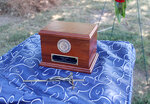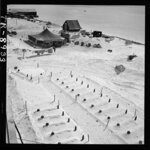



On a sunny Friday morning, about a dozen members of the Teter family gathered around a gravesite in the picturesque St. Ann’s Cemetery, rural Long Grove. As birds chirped, Father Joseph Wolf said prayers for the veteran whose remains lay before them.
The quiet of the morning was broken as members of the Edward W. Knapper VFW Post 6174 of Eldridge fired off three rifle volleys, and bugler Duane Miller played taps in the distance.
Although Miller and fellow VFW members Brad Striegel, Jim Kuhl, Ron Sebastian, Jeff Furgerson and Dave Peiffer knew the funeral was for a World War II veteran, they could not have anticipated what they would learn when they began speaking with the family after the service.
Because this was no ordinary military funeral. The veteran, Pvt. Fay Gene Teter, had been killed in action in 1943.
Teter was just weeks away from his 18th birthday when he was killed on Betio Island during the Battle of Tarawa, one of the bloodiest battles of World War II. Nearly 6,400 Americans, Japanese and Koreans were killed during the three-day fight. The American forces, which included members of the Marine Corps and Navy, sustained about 3,000 casualties, with nearly 1,000 dead.
Joining the war effort
Fay Gene Teter was born in Ardmore, Mo., on Dec. 11, 1925, the oldest of four children of Fay Parker and Bertha Boyd Teter. In 1929, the family relocated to Rock Island, where young Fay attended the local schools. He was a member of the wrestling team at Rock Island High School, where he was expected to graduate with the Class of 1944.
His plans changed, however, when the U.S. entered World War II in 1942. Teter left school to work for Rock Island Bridge and Iron Works to help with the war effort. Military recruitment standards changed with the outbreak of war, and Teter was able to enlist after his 17th birthday, just days after the first anniversary of Pearl Harbor.
“Fay Gene, like a lot of kids back then, he decided to go ahead and join the Marines,” said Teter’s nephew, Norman Teter Jr., who was present at the burial ceremony.
Teter officially joined the Marines at Chicago on Feb. 23, 1943. After training in San Diego and advanced infantry school at Camp Elliott in California, he was sent to New Zealand. On Sept. 23, 1943, he joined Company A, First Battalion, 6th Marines, a reserve unit.
By late October, Teter and his cohort boarded a transport and prepared for combat in the South Pacific.
The U.S. military was working on a plan to take the Mariana Islands to set up airbases to support operations in the Pacific. To do so, they would need to go through the Marshall Islands. However, there was a Japanese garrison and airbase on Betio Island on the Tarawa Atoll in the nearby Gilbert Islands. In order to take the Marianas, the military would have to go through Tarawa.
The Japanese had long recognized the strategic importance of the Gilbert Islands and had fortified accordingly. Rear admiral Keiji Shibazaki reportedly told his troops “It would take one million men one hundred years” to take Tarawa.
The attack was led by the 2nd Marine Division, which had recently fought at the Battle of Guadalcanal. The Battle of Tarawa began on Nov. 20, 1943.
“The first groups came in on the north shore and waded through, and it was a hellacious battle,” said Norman Teter Jr. He said his uncle’s reserve unit “came around on the west side. They were going to move across the island to take the airstrip.
“Well, the reserves that were ahead of them ran into fierce fighting from the Japanese trying to hold it.”
Teter’s company went up to relieve the reserves. “And during the night, they had a lot more fighting, some it hand-to-hand,” said Teter Jr.
The battle continued, and on the third day, Nov. 22, Teter was back in action.
“There was a fella that my dad talked to on the phone that was there with (Fay). He said they were moving across an area and there was a Japanese machine gun that got six of them before they got the Japanese machine gun. And my uncle was one of them,” said Teter Jr. “He was shot in the chest and head and died pretty much instantly right there.”
Pvt. Fay Gene Teter was just 17 years old.
On Nov. 23, 76 hours after the battle began, the U.S. military captured Betio Island.
That day, Teter was reportedly buried along with dozens of other Marines from his battalion, in what was referred to in documents as “Row D” of the Gilbert Islands Cemetery. However, any formal marking of the spot was destroyed soon after the battle, and the military was left with only a rough set of coordinates as to where Teter’s remains lay.
After Tarawa
Meanwhile, military communications were much slower during World War II, and news of Teter’s death did not reach his family until December.
“I’ve still got the original telegram that states that he was killed in action,” said Teter Jr.
Fay Teter’s sister, Bonnie, was the one who had initial contact with the telegram.
“His sister … hid it from her mom and everyone until after Christmas,” said Teter Jr. “She wouldn’t tell anyone about it. And it was a really hard thing to do.”
In addition to his family, Fay Teter was mourned by his fiancée, Lela Mae Crouch, a classmate at Rock Island High School. The pair became engaged in 1942, and Lela had promised to wait for Fay.
The U.S. military held Tarawa until withdrawing in 1944. Teter’s unit, the 6th Marines, initially stayed to clear the island of ordinance and provide security for Seabees who were sent in to rebuild the airstrip.
Also in 1944, a short film was released called “With the Marines at Tarawa,” a documentary filmed by Marine Staff Sgt. Norman T. Hatch, that showed the battle in uncensored detail. It was so graphic, only the president, Franklin Roosevelt, could grant permission for its release to the general public. After consulting with Time-Life photographer Robert Sherrod, who was present at the battle, Roosevelt gave his approval.
“I tell the President the truth,” said Sherrod. “Our soldiers on the front want people back home to know that they don’t knock the hell out of them every day of every battle. They want people to understand that war is a horrible, nasty business, and to say otherwise is to do a disservice to those who died.”
The film and the U.S. Marines went on to win the Academy Award for Best Documentary Short Subject. Due to the shortage of metal during the war, the Marines received a plaster statue in the shape of a tablet.
Life moved on. Teter’s parents divorced in the 1940s, and his mother Bertha worked at the Rock Island Arsenal for 27 years before retiring in 1970. She died Dec. 2, 1997, and was buried at St. Ann’s Cemetery in Long Grove. Teter’s father died in 1972 and is buried in Missouri.
Lela Mae Crouch joined the WAVES, the women’s unit of the Naval Reserves, in 1945. She later moved to Michigan, where she married a man named Elton Iles. She died in 2014.
History Flight
For years, Teter’s body was thought to be unrecoverable. His name was placed on a memorial called the Courts of the Missing at the National Memorial Cemetery of the Pacific in Hawaii.
In 2003, a non-profit agency called History Flight was established to help research, recover and repatriate service members who were listed as Missing in Action or deemed non-recoverable. Based out of Fredericksburg, Va., the organization has recovered the remains of more than 130 missing services members in both the European and Pacific theaters of war.
History Flight set up a team on Tarawa in 2009, and 10 years later, a previously lost burial site thought to be Row D was discovered. More than 30 remains were recovered from the site and turned over to the Defense POW/MIA Accounting Agency (DPAA), part of the Department of Defense. All the remains were flown to Hawaii for identification
The DPAA went to work searching for the next-of-kin for each, and eventually contacted Teter’s younger brother, Norman Teter Sr., who lives in Moline.
“He was in Section D. It was not the regular burial area. So when they found them, they wanted to make sure everything came to the family,” he said.
“They asked for my DNA, and then they matched it,”
Fay Gene Teter’s remains were officially identified on Aug. 2, 2022.
Teter’s family decided to bury him next to his mother at St. Ann’s. The remains were flown from Hawaii to the Dallas-Fort Worth airport and returned to the family for burial on June 9.
A group of family members from Illinois were present at the ceremony, including Norman Teter Sr. and his son, and Fay’s sister, Judy Hartman of New Boston, Ill. Sister Bonnie Bopes died in 2019.
Members of the Eldridge VFW were contacted to provide military services. They were all touched by the ceremony.
“I think it’s quite an honor to be able to provide military funeral honors to a Tarawa Marine Corps veteran, who participated in one of the bloodiest battles in the Pacific,” said Striegel. “Just to know that the family, after 70-odd years, has their family member back and identified. It’s just incredible. And it’s a testament to what the Defense POW/MIA Accounting Agency does. They’re all over the world doing this, collecting the remnants of loved ones, slowing taking them off that Missing in Action roster.”
Fay Gene Teter left a legacy for his family, even members that never knew him.
“I always say, it was kind of funny,” said Norman Teter Jr. “He went in when he was 17, my dad went in for the Korean War when he was 17, and I went in at the end of Vietnam when I was 17. We all had to have someone sign for us to get in.
“We’ve always been very proud of Fay Gene. I always think, if he was alive today, he’d be 97 years old.”
Standing near the small box containing his brother’s remains, Norman Sr. reflected, 'We’re just glad we could get him back home.'